2020 Hyundai Ioniq Electric belt
[x] Cancel search: beltPage 442 of 561

7-36
Maintenance
All Season Tires
HYUNDAI specifies all season tires
on some models to provide good
performance for use all year round,
including snowy and icy road condi-
tions. All season tires are identified
by ALL SEASON and/or M+S (Mud
and Snow) on the tire sidewall. Snow
tires have better snow traction than
all season tires and may be more
appropriate in some areas.
Summer Tires
HYUNDAI specifies summer tires on
some models to provide superior
performance on dry roads. Summer
tire performance is substantially
reduced in snow and ice. Summer
tires do not have the tire traction rat-
ing M+S (Mud and Snow) on the tire
side wall. If you plan to operate your
vehicle in snowy or icy conditions,
HYUNDAI recommends the use of
snow tires or all season tires on all
four wheels.
Snow Tires
If you equip your car with snow tires,
they should be the same size and
have the same load capacity as the
original tires. Snow tires should be
installed on all four wheels; other-
wise, poor handling may result. Snow
tires should carry 4 psi (28 kPa)
more air pressure than the pressure
recommended for the standard tires
on the tire label on the driver’s side of
the center pillar, or up to the maxi-
mum pressure shown on the tire
sidewall, whichever is less. Do not
drive faster than 75 mph (120 km/h)
when your vehicle is equipped with
snow tires.
Radial-Ply Tires
Radial-ply tires provide improved
tread life, road hazard resistance and
smoother high speed ride. The radi-
al-ply tires used on this vehicle are of
belted construction, and are selected
to complement the ride and handling
characteristics of your vehicle.
Radial-ply tires have the same load
carrying capacity, as bias-ply or bias
belted tires of the same size, and use
the same recommended inflation
pressure. Mixing of radial-ply tires
with bias-ply or bias belted tires is
not recommended. Any combina-
tions of radial-ply and bias-ply or bias
belted tires when used on the same
vehicle will seriously deteriorate
vehicle handling. The best rule to fol-
low is: Identical pairs of radial-ply
tires should always be used as a set
for the front tires and a set for the
rear tires.
Page 476 of 561
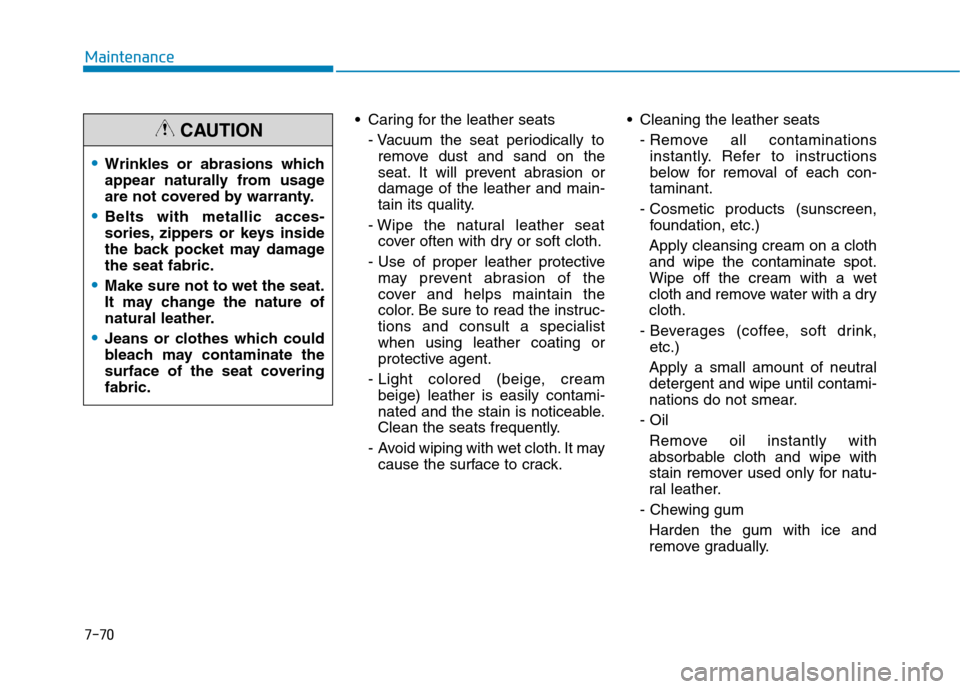
7-70
Maintenance
Caring for the leather seats
- Vacuum the seat periodically to
remove dust and sand on the
seat. It will prevent abrasion or
damage of the leather and main-
tain its quality.
- Wipe the natural leather seat
cover often with dry or soft cloth.
- Use of proper leather protective
may prevent abrasion of the
cover and helps maintain the
color. Be sure to read the instruc-
tions and consult a specialist
when using leather coating or
protective agent.
- Light colored (beige, cream
beige) leather is easily contami-
nated and the stain is noticeable.
Clean the seats frequently.
- Avoid wiping with wet cloth. It may
cause the surface to crack. Cleaning the leather seats
- Remove all contaminations
instantly. Refer to instructions
below for removal of each con-
taminant.
- Cosmetic products (sunscreen,
foundation, etc.)
Apply cleansing cream on a cloth
and wipe the contaminate spot.
Wipe off the cream with a wet
cloth and remove water with a dry
cloth.
- Beverages (coffee, soft drink,
etc.)
Apply a small amount of neutral
detergent and wipe until contami-
nations do not smear.
- Oil
Remove oil instantly with
absorbable cloth and wipe with
stain remover used only for natu-
ral leather.
- Chewing gum
Harden the gum with ice and
remove gradually.
Wrinkles or abrasions which
appear naturally from usage
are not covered by warranty.
Belts with metallic acces-
sories, zippers or keys inside
the back pocket may damage
the seat fabric.
Make sure not to wet the seat.
It may change the nature of
natural leather.
Jeans or clothes which could
bleach may contaminate the
surface of the seat covering
fabric.
CAUTION
Page 477 of 561
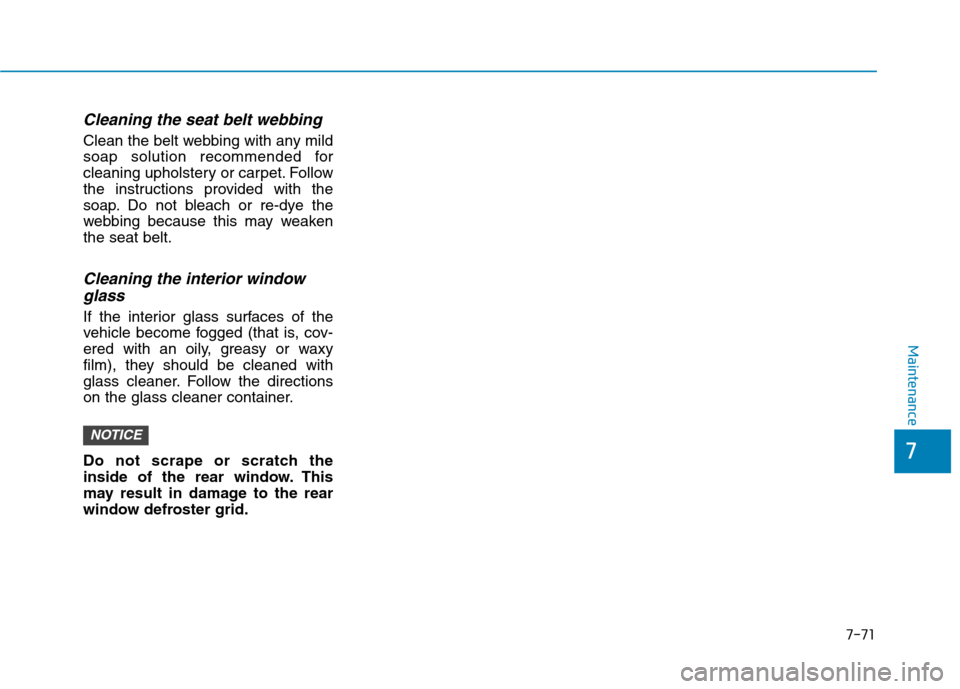
7-71
7
Maintenance
Cleaning the seat belt webbing
Clean the belt webbing with any mild
soap solution recommended for
cleaning upholstery or carpet. Follow
the instructions provided with the
soap. Do not bleach or re-dye the
webbing because this may weaken
the seat belt.
Cleaning the interior window
glass
If the interior glass surfaces of the
vehicle become fogged (that is, cov-
ered with an oily, greasy or waxy
film), they should be cleaned with
glass cleaner. Follow the directions
on the glass cleaner container.
Do not scrape or scratch the
inside of the rear window. This
may result in damage to the rear
window defroster grid.
NOTICE
Page 478 of 561
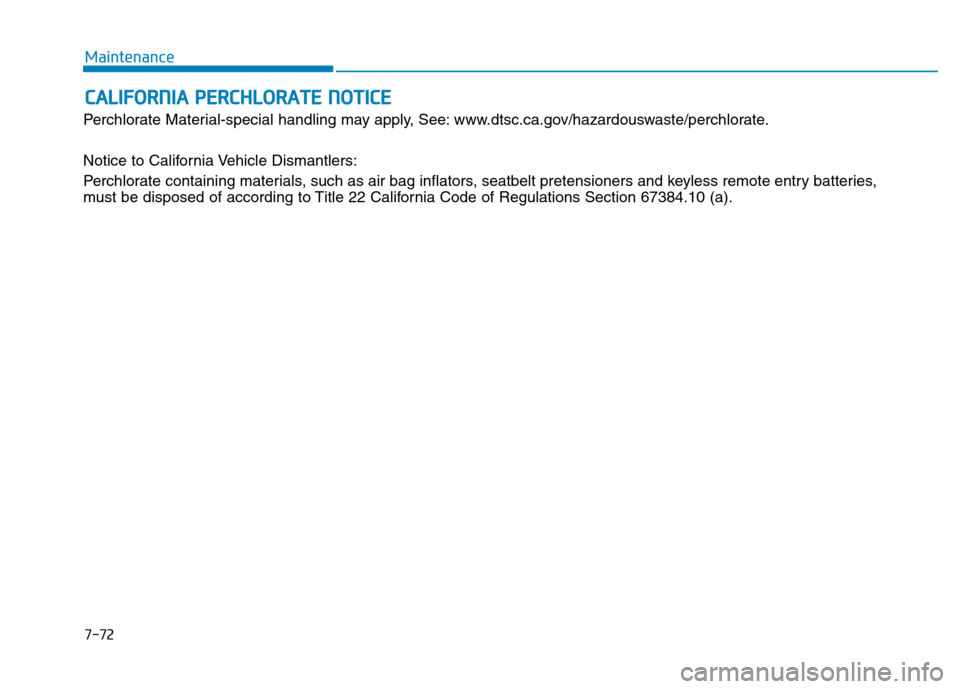
C CA
AL
LI
IF
FO
OR
RN
NI
IA
A
P
PE
ER
RC
CH
HL
LO
OR
RA
AT
TE
E
N
NO
OT
TI
IC
CE
E
Perchlorate Material-special handling may apply, See: www.dtsc.ca.gov/hazardouswaste/perchlorate.
Notice to California Vehicle Dismantlers:
Perchlorate containing materials, such as air bag inflators, seatbelt pretensioners and keyless remote entry batteries,
must be disposed of according to Title 22 California Code of Regulations Section 67384.10 (a).Maintenance
7-72
Page 487 of 561

8-9
88
Specifications, Consumer information and Reporting safety defects
Eastern Region:
Connecticut, Maine, Massachusetts,
New Hampshire, New Jersey, New
York, Pennsylvania, Rhode Island,
Vermont. Eastern Region 1122
Cranbury South River Road
Jamesburg, NJ 08831 (800) 633-
5151
Mid Atlantic Region:
Delaware, Maryland, North Carolina,
Virginia, West Virginia
Mid Atlantic
1753 Pinnacle Drive, South Tower,
Floor 11 McLean, VA 22102 (800)
633-5151 Southern Region:
Alabama, Florida, Georgia, South
Carolina, Tennessee West Virginia.
Southern Region 3025 Chastain
Meadows Parkway Suite 100
Marietta, GA 30066 (800) 633-5151
South Central Region:
Arkansas, Louisiana,
Kansas,Mississippi, Missouri,
Oklahoma,Texas. South Central
Region 1421 South Beltline Road,
Suite 400 Coppell, TX 75019 (800)
633-5151 Central Region:
Illinois, Indiana, lowa,
Kentucky,Michigan, Minnesota, Ohio,
Wisconsin Central Region 2 Trans
Am Plaza Dr #500 Oakbrook
Terrace, IL 60181 (800) 633-5151
Western Region:
Alaska, Hawaii, California,
Nevada,Oregon, Washington
Western Region 10550 Talbert
Avenue P.O.Box Fountain Valley,
CA(800) 633-5151
Mountain States Region:
Arizona, Colorado, Idaho, Montana,
Nebraska, North Dakota, New
Mexico, South Dakota, Utah,
Wyoming (800) 633-5151
C CO
ON
NS
SU
UM
ME
ER
R
I
IN
NF
FO
OR
RM
MA
AT
TI
IO
ON
N
This consumer information has been prepared in accordance with regulations issued by the National Highway Traffic
Safety Administration of the U.S. Department of Transportation. Your HYUNDAI dealer will help answer any questions you
may have as you read this information.
HYUNDAI motor vehicles are designed and manufactured to meet or exceed all applicable safety standards.
For your safety, however, we strongly urge you to read and follow all directions in this Owner’s Manual, particularly the
information under the headings "NOTICE", "CAUTION" and "WARNING".
If, after reading this manual, you have any questions regarding the operation of your vehicle, please contact your nearest
HYUNDAI Motor America Regional Office as listed in the following:
Page 534 of 561
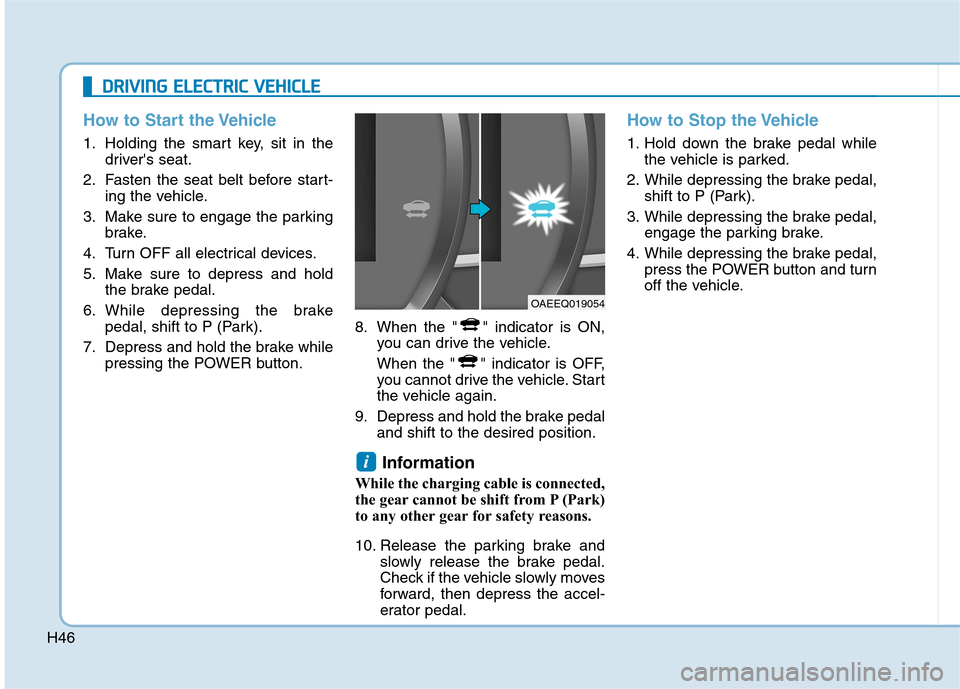
H46
How to Start the Vehicle
1. Holding the smart key, sit in the
driver's seat.
2. Fasten the seat belt before start-
ing the vehicle.
3. Make sure to engage the parking
brake.
4. Turn OFF all electrical devices.
5. Make sure to depress and hold
the brake pedal.
6. While depressing the brake
pedal, shift to P (Park).
7. Depress and hold the brake while
pressing the POWER button.8. When the " " indicator is ON,
you can drive the vehicle.
When the " " indicator is OFF,
you cannot drive the vehicle. Start
the vehicle again.
9. Depress and hold the brake pedal
and shift to the desired position.
Information
While the charging cable is connected,
the gear cannot be shift from P (Park)
to any other gear for safety reasons.
10. Release the parking brake and
slowly release the brake pedal.
Check if the vehicle slowly moves
forward, then depress the accel-
erator pedal.
How to Stop the Vehicle
1. Hold down the brake pedal while
the vehicle is parked.
2. While depressing the brake pedal,
shift to P (Park).
3. While depressing the brake pedal,
engage the parking brake.
4. While depressing the brake pedal,
press the POWER button and turn
off the vehicle.
i
D DR
RI
IV
VI
IN
NG
G
E
EL
LE
EC
CT
TR
RI
IC
C
V
VE
EH
HI
IC
CL
LE
E
OAEEQ019054
Page 557 of 561
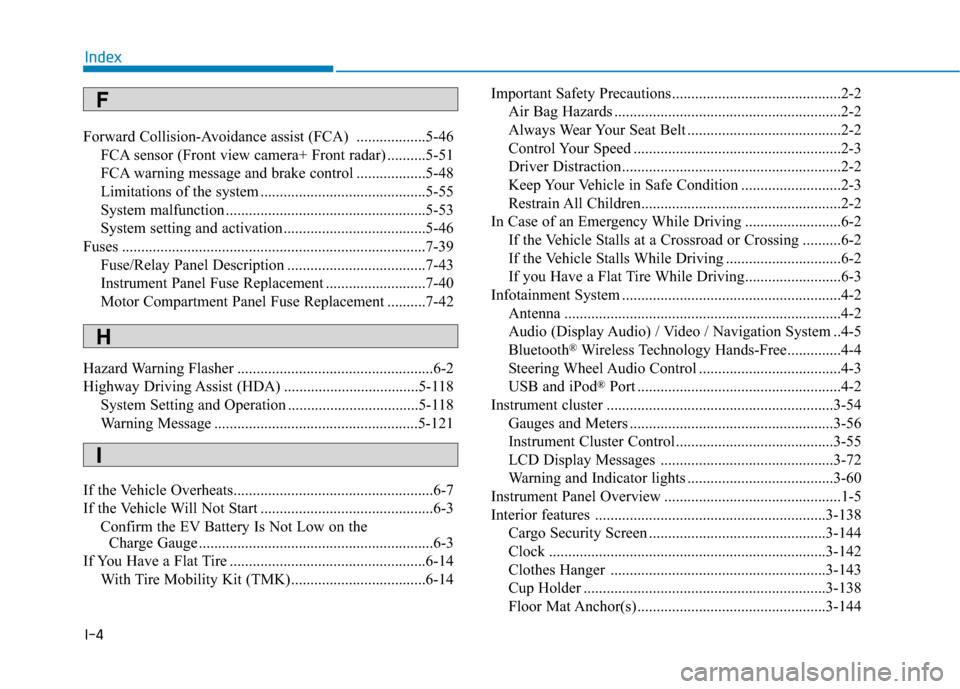
I-4
Forward Collision-Avoidance assist (FCA) ..................5-46
FCA sensor (Front view camera+ Front radar) ..........5-51
FCA warning message and brake control ..................5-48
Limitations of the system ...........................................5-55
System malfunction ....................................................5-53
System setting and activation .....................................5-46
Fuses ...............................................................................7-39
Fuse/Relay Panel Description ....................................7-43
Instrument Panel Fuse Replacement ..........................7-40
Motor Compartment Panel Fuse Replacement ..........7-42
Hazard Warning Flasher ...................................................6-2
Highway Driving Assist (HDA) ...................................5-118
System Setting and Operation ..................................5-118
Warning Message .....................................................5-121
If the Vehicle Overheats....................................................6-7
If the Vehicle Will Not Start .............................................6-3
Confirm the EV Battery Is Not Low on the
Charge Gauge .............................................................6-3
If You Have a Flat Tire ...................................................6-14
With Tire Mobility Kit (TMK)...................................6-14Important Safety Precautions............................................2-2
Air Bag Hazards ...........................................................2-2
Always Wear Your Seat Belt ........................................2-2
Control Your Speed ......................................................2-3
Driver Distraction.........................................................2-2
Keep Your Vehicle in Safe Condition ..........................2-3
Restrain All Children....................................................2-2
In Case of an Emergency While Driving .........................6-2
If the Vehicle Stalls at a Crossroad or Crossing ..........6-2
If the Vehicle Stalls While Driving ..............................6-2
If you Have a Flat Tire While Driving.........................6-3
Infotainment System .........................................................4-2
Antenna ........................................................................4-2
Audio (Display Audio) / Video / Navigation System ..4-5
Bluetooth
®Wireless Technology Hands-Free..............4-4
Steering Wheel Audio Control .....................................4-3
USB and iPod
®Port .....................................................4-2
Instrument cluster ...........................................................3-54
Gauges and Meters .....................................................3-56
Instrument Cluster Control .........................................3-55
LCD Display Messages .............................................3-72
Warning and Indicator lights ......................................3-60
Instrument Panel Overview ..............................................1-5
Interior features ............................................................3-138
Cargo Security Screen ..............................................3-144
Clock ........................................................................3-142
Clothes Hanger ........................................................3-143
Cup Holder ...............................................................3-138
Floor Mat Anchor(s) .................................................3-144
Index
F
I
H
Page 559 of 561
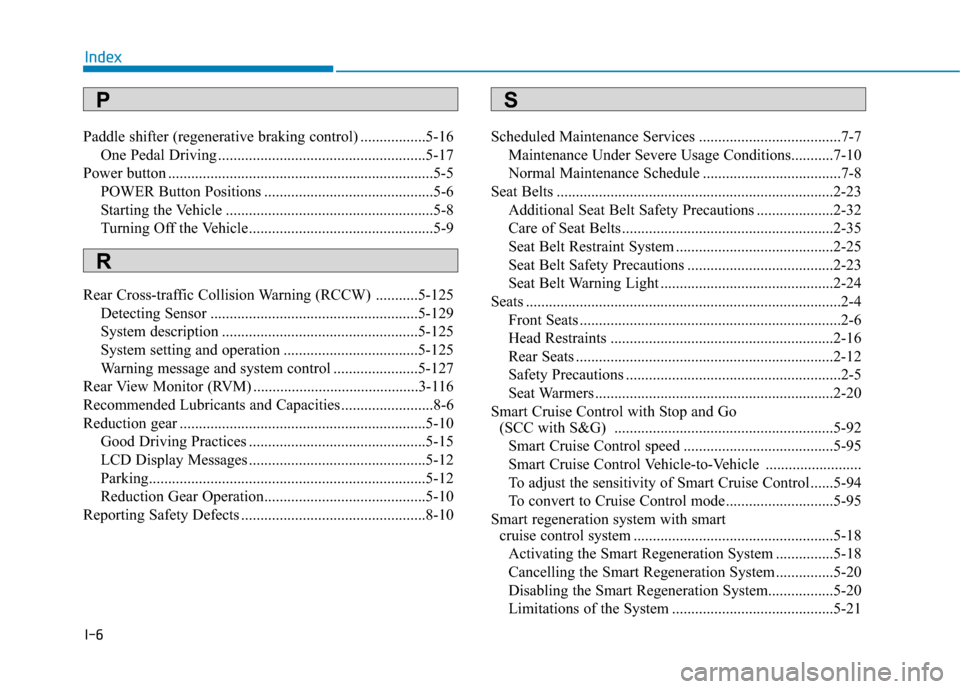
I-6
Paddle shifter (regenerative braking control) .................5-16
One Pedal Driving ......................................................5-17
Power button .....................................................................5-5
POWER Button Positions ............................................5-6
Starting the Vehicle ......................................................5-8
Turning Off the Vehicle................................................5-9
Rear Cross-traffic Collision Warning (RCCW) ...........5-125
Detecting Sensor ......................................................5-129
System description ...................................................5-125
System setting and operation ...................................5-125
Warning message and system control ......................5-127
Rear View Monitor (RVM) ...........................................3-116
Recommended Lubricants and Capacities ........................8-6
Reduction gear ................................................................5-10
Good Driving Practices ..............................................5-15
LCD Display Messages ..............................................5-12
Parking........................................................................5-12
Reduction Gear Operation..........................................5-10
Reporting Safety Defects ................................................8-10Scheduled Maintenance Services .....................................7-7
Maintenance Under Severe Usage Conditions...........7-10
Normal Maintenance Schedule ....................................7-8
Seat Belts ........................................................................2-23
Additional Seat Belt Safety Precautions ....................2-32
Care of Seat Belts .......................................................2-35
Seat Belt Restraint System .........................................2-25
Seat Belt Safety Precautions ......................................2-23
Seat Belt Warning Light .............................................2-24
Seats ..................................................................................2-4
Front Seats ....................................................................2-6
Head Restraints ..........................................................2-16
Rear Seats ...................................................................2-12
Safety Precautions ........................................................2-5
Seat Warmers ..............................................................2-20
Smart Cruise Control with Stop and Go
(SCC with S&G) .........................................................5-92
Smart Cruise Control speed .......................................5-95
Smart Cruise Control Vehicle-to-Vehicle .........................
To adjust the sensitivity of Smart Cruise Control ......5-94
To convert to Cruise Control mode............................5-95
Smart regeneration system with smart
cruise control system ....................................................5-18
Activating the Smart Regeneration System ...............5-18
Cancelling the Smart Regeneration System ...............5-20
Disabling the Smart Regeneration System.................5-20
Limitations of the System ..........................................5-21
Index
SP
R